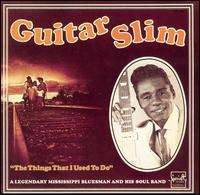The Things That I Used to Do
| "The Things That I Used to Do" | |||||||
|---|---|---|---|---|---|---|---|
 | |||||||
| Single by Guitar Slim | |||||||
| Released | 1953[1] | ||||||
| Format | 7" single | ||||||
| Recorded |
October 16, 1953,[2] Matassa's J&M Studio,[2] New Orleans | ||||||
| Genre | Blues, Electric blues, New Orleans blues | ||||||
| Length | 3:38 | ||||||
| Label | Specialty Records | ||||||
| Writer(s) | Guitar Slim | ||||||
| Producer(s) | Ray Charles | ||||||
| Guitar Slim singles chronology | |||||||
| |||||||
| |||||||
| "The Things That I Used to Do" | ||||
|---|---|---|---|---|
| Single by James Brown | ||||
| from the album Showtime | ||||
| B-side | "Out of the Blue" | |||
| Released | 1964 | |||
| Format | 7" | |||
| Genre | Rhythm and blues | |||
| Length | 2:55 | |||
| Label |
Smash 1908 | |||
| Writer(s) | Eddie (Guitar Slim) Jones | |||
| Producer(s) | Fair Deal Record Corp. | |||
| James Brown charting singles chronology | ||||
| ||||
"The Things That I Used to Do" is a 12-bar blues song written by Guitar Slim (aka Eddie Jones). His recording of it, made in New Orleans, was arranged and produced by a young Ray Charles.[3] It was released on Specialty Records in 1953,[1] and became a bestseller the following year. It was one of the biggest hits in the label's history and stayed on the rhythm and blues charts for 42 weeks.[4] The song was at #1 for six weeks, and was the best-selling R&B record of the year, selling more than a million copies.[2]
Since Guitar Slim was a blues artist, Specially Record's Art Rupe figured that his appeal would be limited to the Southern rural audience. However, urban R&B stations in the North picked up the song, pushing it into a national hit. As a result, Guitar Slim became in great demand as a performer and played on the stage of the Apollo Theater.[4]
Song
Ray Charles's arrangement and piano accompaniment emphasizes the religious tone of intense but philosophical regret in the singer's voice, giving the song a gospel-influenced feel. Like Fats Domino, Guitar Slim's voice has a less adult sound than does that of the typical blues shouters of the time and his lyrics are less explicitly sexual.[5]
The song required numerous takes to record. Jones often stopped playing in the middle of the song for some reason and they had to start from the beginning again. (Even in the take which was issued, Jones resumes the vocal after the instrumental chorus half a bar early, singing and playing two beats ahead of the band for the first eight bars of the final chorus.) During the song's fadeout Ray Charles can be heard shouting "yeah!" for he realizes that they finally managed to make it to the end.
Legacy
The song was a huge success, greatly influencing rock and roll by demonstrating the commercial success of using content that appeals to white listeners and by the effectiveness of its gospel feel.[5] It has become a standard due to Guitar Slim's distinctive guitar figuring and the rising and falling melody.[6] It had a major impact on "the electric sound" of rock music and featured distorted overtones on the electric guitar a full decade before Jimi Hendrix.[2] It has been listed by the Rock and Roll Hall of Fame as one of the 500 songs that shaped rock and roll.[7] It also contributed to the development of soul music.[8]
The song has been covered by many artists:
- Albert Collins
- Ike & Tina Turner
- Stevie Ray Vaughan[9]
- Junior Parker
- Muddy Waters
- Lightnin' Slim
- Jimi Hendrix
- Freddie King
- Chuck Berry
- Big Joe Turner - (1977)
- Elvin Bishop and The Grateful Dead in performance only - (1969)[10]
- G. Love and Special Sauce - (1994)
- Buddy Guy
- Luther Allison
- John Mayer
- Dan Auerbach (With his pre-The Black Keys band The Barnburners)
- Richie Havens
- James Brown, whose 1964 recording charted #99 Pop.[11]
- Sanchez
References
- 1 2 "Guitar Slim And His Band – The Things That I Used To Do". Discogs. Retrieved 2 July 2012.
- 1 2 3 4 Aswell, Tom (2010). Louisiana Rocks! The True Genesis of Rock & Roll. Gretna, Louisiana: Pelican Publishing Company. pp. 61–5. ISBN 1589806778.
- ↑ "Black History - Ray Charles". Gale.com. Retrieved 2006-11-05.
- 1 2 "Guitar Slim (Eddie Jones)©2002JCMarion". Home.earthlink.net. Retrieved 2006-11-05.
- 1 2 Gillett, Charlie (1996). The Sound of the City: The Rise of Rock and Roll ((2nd Ed.) ed.). New York, N.Y.: Da Capo Press. pp. 139–140, 170. ISBN 0-306-80683-5.
- ↑ Watrous, Peter (August 19, 1990). "A Young Blues Guitarist Intent on Modernization". The New York Times. Retrieved 2006-11-05.
- ↑ "500 Songs That Shaped Rock". Infoplease.com. Retrieved 2006-11-05.
- ↑ R. Unterberger, "Louisiana blues", in V. Bogdanov, C. Woodstra, S. T. Erlewine, eds, All Music Guide to the Blues: The Definitive Guide to the Blues (Milwaukee, WI: Backbeat Books, 3rd edn., 2003), ISBN 0-87930-736-6, pp. 687-8.
- ↑ "Stevie Ray Vaughan and Double Trouble". Sonymusic.com. Archived from the original on March 20, 2006. Retrieved 2006-11-05.
- ↑ "Sung by Elvin Bishop with the Grateful Dead on 8 June 1969". Deaddisc.com. Retrieved 2006-11-05.
- ↑ White, Cliff (1991). "Discography". In Star Time (pp. 54–59) [CD booklet]. New York: PolyGram Records.
External links
| Preceded by "Money Honey" by Clyde McPhatter and The Drifters |
Billboard R&B National Best Sellers number-one single January 30, 1954 February 13, 1954 |
Succeeded by "I'll Be True" by Faye Adams "You'll Never Walk Alone" by Roy Hamilton |